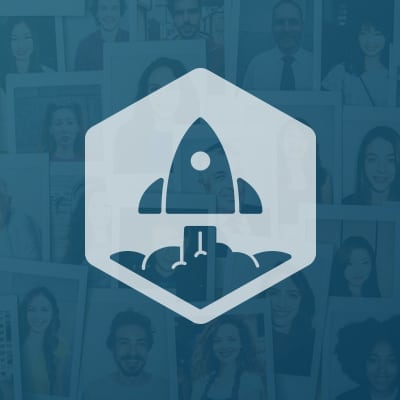Managing change when your company is going through hyper-growth is exciting and frightening all at once. There’s no set playbook for it since every company is different and the landscape changes all the time. That being said, we can learn a lot from the experiences of three former Salesforce execs who were with the company from $22 million in revenue past IPO to $5 billion in revenue.
Matt Garratt, VP at Salesforce Ventures, sits down with David Obrand, COO at Radius Intelligence; Bill Macaitis, Advisor at Macaitis Advisory; and Kendall Collins, CMO at AppDynamics, to discuss how they helped Salesforce survive and thrive in their respective roles.
How did they think about hiring the right people? Building infrastructure? Doing experiments, failing and learning from that? We get an insightful look into how Salesforce has gone through an incredible evolution from its early days until now.
And if you haven’t heard: SaaStr Annual will be back in 2018, bigger and better than ever! Join 10,000 fellow founders, investors and execs for 3 days of unparalleled networking and epic learnings from SaaS legends like Eric Yuan, Tomasz Tunguz, Chris O’Neill, and Mikkel Svane. If you don’t have tickets, lock in Early Bird pricing today and bring your team from just $799! (All ticket prices go up November 1st.) Get tickets here.
TRANSCRIPT
Announcer: Please welcome, from Salesforce Ventures, VP Matt Garratt.
Matt Garratt: I’m really excited about this panel. We have three amazing guests. Where are the slides showing up? Oh, over here.
Three former Salesforce execs who were there from $22 million in revenue past IPO to $5 billion in revenue, which is amazing, have gone on to join amazing companies such as Zendesk and Yammer and AppDynamics, and have been transformative in the marketplace and critical in how you grow in scale, sales and marketing organizations.
We’re going to have a nice discussion about, how do you manage change in hypergrowth mode? Without further ado, I would like to bring up Dave Obrand and Bill Macaitis and Kendall Collins.
Matt: All right, thanks guys. I’ll go down and introduce you. We’re sitting in chronological order in which they joined Salesforce. We’ll spend a bit of time talking about their experience at Salesforce. These are plush chairs, aren’t they?
David Obrand: It’s lovely.
Matt: Very nice.
We’ll spend a bit of time talking about their experience at Salesforce, and then also how they grew and the change that they went through there personally, organizationally, and then some of the companies that they’ve been to subsequent. David Obrand, you joined in what year?
David: March 2002.
Matt: The company was at $22 million in revenue at the time?
David: Yeah.
Matt: Talk about what your first role was when you joined in the sales organization. What was the sales organization like at the time? What was so exciting and prompted you to join the company?
David: We had at the time, I came in the first wave of field reps. They’d hire everyone who’d primarily been corporate before. Worked out of San Francisco, 50 bucks a month, month to month contracts.
First day came on, I was going to get my territory and they said, “It was going to be the Bay Area, but now it’s going to be Illinois but not Chicago.” But Tennessee. “And here’s your big, 60 pound desktop, and go to it.”
It was a really interesting company. You see companies that grow up using the tool they build, and it really reflects on the culture. Obviously being a Pipeline Forecasting SFA tool at the time, we lived and breathed the product.
It was a very high performing culture. I think, one of the things we were talking about before, it was an incredibly progressive culture at the time, and company. Marc really emphasized not only how we thought about the culture of the company and looked at every hire, but was really the first company that I can think of that didn’t think about creating the identity around a department.
Is it an engineering driven company? Is it a sales driven company? It really was a customer driven company from the beginning, and I think that is what drove some of the great cross functional collaboration we had in the sales and marketing. It was definitely a 12 sprints a year, high performing, high expectation culture.
Matt: Was that different than other companies you’d been at before?
David: It was, simply because the cadence was very different. Being one of the first real SaaS companies, we developed much faster, the sales cycles were much shorter. We were, at the time, selling to users and small teams, rather than selling to a CIO, for example.
The first couple years, I think it was gone by the time you were there, the home page of the website had in huge red letters, “No IT Required.” Every time you’d go on a sales call, the CIO would come in and basically just yell at you for like 15 minutes and then leave. But the product was so good, you would end up selling to the users, and it was a great sort of bottoms up movement.
Matt: Got it. I want to introduce Kendall in a second, but before I do, Kendall came in in…What year did you come in?
Kendall Collins: Beginning of ’04.
Matt: ’04. So the company was about $95 million in revenue. Talk about, from the sales perspective, what were the biggest changes from an organization, or technology, to get to $95 million in revenue? What were the biggest hurdles you had to get through?
David: Between 22 and 95…When you came on, we had enterprise edition, right?
Kendall: We had just launched enterprise edition.
David: 125 bucks. In those two years, we went from, I remember one of the first deals I did was $38K, and Marc actually came running out of his office, and he was so excited. Then one of the last deals we did was like $70 million, and I got a one line email that said, “Should have been 100.”
[laughter]
David: It’s like, how 10 years sort of changes perspective.
We really had to grow up a lot. The infrastructure, security, at that point, the product had evolved enough that we were now selling both to sales and marketing.
We had to sell to CIOs at the time, so our messaging became much more nuanced. It was a much more sophisticated message, and the competencies that we looked for in the reps were very different in ’04 than they were in ’02.
Matt: What were you looking for that was different?
David: It was a combination of really strong intellectual horsepower; that was something that was always really important to Marc. Up until ’04, and I think probably after you were there as well, Marc did almost every interview. At some point, he spent time with every single candidate.
Matt: Up till when, he did every interview?
David: I think it was ’04, wasn’t it?
Kendall: He was doing everything. He was everywhere. He was definitely doing every interview for a long time.
David: I remember definitely back in late ’03, seven, eight o’clock at night, he would be sitting with an individual contributor products marketing person, interviewing him.
Technical aptitude was another big one. We really looked for genuine passion for customer success. Marc did such a good job of taking all the goodness when he left Oracle, and thinking about how he wanted a different culture at Salesforce, and really emphasizing that.
We started getting big deals. We started doing the Merrill Lynch deal, the Cisco deal, the SunGard deal, all of those. That required a bit different mind…It’s a little more delayed gratification and consultative nature, and he thought about it.
Matt: Kendall, you joined the company, it was $95 million in revenue. You’ve gone…you had seven or eight roles at Salesforce, at least. You’ve gone on since that to AppDynamics. Talk about the marketing organization when you joined. What was it like? What were some of the new and innovative things you thought Salesforce was doing at the time?
Kendall: It was interesting. When I joined, I actually joined in the sales side. I was in sales operations. I had previously done some product marketing and and product management.
The thing that was incredible is Marc, you could never hope for a better evangelist, a better spokesperson, a personality who could just make the news. He really pioneered, I think, a model of getting earned media in incredible ways.
Bill and I will talk about paid media and earned media, I’m sure at some point in this. Marc, we were just driving an incredible volume of people to the website organically, and they were trying the product.
Matt: Through what Marc was doing at the time?
Kendall: Through PR. This is really before pay per click or anything substantial.
Matt: Was that unique, you think, for an Enterprise executive? When you think of Enterprise SaaS executives now, most of them, the really successful CEOs, they’re larger than life personalities. Do you think Marc was at the forefront of that?
Kendall: Absolutely. I think he had a big idea and a big vision. The whole concept of “no software” was surprising. It was unexpected. It was provocative. It was controversial, clearly, with a lot of IT people.
I spent a lot of time walking into meeting with CIOs, and them going “Of course there’s software. I know there’s software.” I would say, “Well, of course, there’s software.” It would be like FedEx driving around with trucks that on the side of it said, “No trucks.”
The point is, you don’t want to have to worry about the software, and the complexity. He found a different way to go after that. He embraced Salesforce.com. He would not drop the “dot com.” This was in 2001, 2002.
Matt: Just emphasizing no software.
Kendall: It’s like, “We’re going to go harder on the dot com.” I think that’s just such an antithetical position to where the market was, and where the valuations were going.
Matt: Everyone was running away from dot com at that point.
Kendall: People were running. Dot com was a four letter word at that point. I think Marc drove that incredibly hard. People tried the product, they loved the product.
I think for a long time, business people and salespeople, in particular, they felt shackled by IT. They felt like, “I can’t go fast enough, and the IT team can never keep up with me,” because they’ve got to stand up servers and databases, and connect all this crap. It was very hard.
He found another way to the line of business, another way to the money, which I think is really important. Then, I was in sales operations, and I got in there.
The fascinating thing was, we were just saying, “How fast can we hire salespeople?” One of the biggest challenges was, we called it Whack A Mole. Literally, there were so many transactions. It was very high velocity, high volume operation, which is what David’s articulating.
I think Allison, do you remember Allison from inside sales, she was our top rep like two years in a row. I think the first year I was there, she did something like 370 transactions. Sales transactions, with contracts and wet signatures. It’s amazing when you think about that volume, and how all those small deals really added up.
Matt: How were you able to maintain that growth, because there really wasn’t a model for that, of that high velocity sales model, continually bringing in salespeople. Operationally, how did you train the reps? How did you maintain the productivity?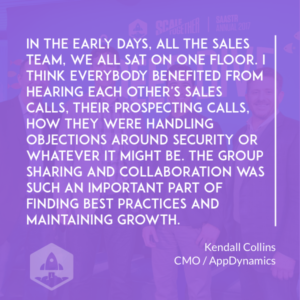
Kendall: I think one of the things that was interesting about Salesforce is that, early days, all the sales team, we all sat on one floor. I think everybody benefited from hearing each other’s sales calls, their prospecting calls, how they were handling objections around security or whatever it might be. How they were blaming WebEx if the app was slow in the demo they were giving. “Oh, this WebEx! It must be the WebEx!”
It was amazing, but I think the group sharing and collaboration was such an important part of finding best practices. A lot of what we were doing, from an operations and a product marketing perspective, was trying to find the best stories, find the best sales playbook, and just share what was working, like, “David’s doing this thing over here, it’s amazing.”
Matt: What do you mean stories? Customer stories?
Kendall: Whether it’s customer stories or how to handle objections. Objection handling was a big part of our sales training. I taught objection handling for six or seven years with a guy named Dan Dal Degan.
We taught it literally every month in sales boot camp because we felt that, if you could understand all the objections in a deal and you could really handle them and overcome them, then there’s no obstacle to a deal.
We really tried to be maniacal about understanding all the objections and categorizing them and answering them, and giving people the customer stories to overcome that.
David: You guys also did a really good job, though, from a sales ops perspective, of driving aptitude around the product. It was one of the first real enterprise products that the reps were expected to demo themselves.
I think that gave us a lot of credibility as a sales team. It was also sort of a common rallying cry. That was one of the core values that your team really drove.
Kendall: It was a big Marc thing, too. Marc loved to demo the product. The sheer nature of what we were selling, it helped. We had an unfair advantage, that the salespeople were using the product. Marc’s favorite thing to do, and for a lot of reps their favorite thing to do, was they could go in and change the language, which at the time was revolutionary.
Like, “Oh, let me show you in setup. I click over here, I click over here, I can change it to Chinese or I can change it to Japanese.” Getting it back is the hard part.
David: I was going to say. Now it’s in Mandarin.
Kendall: All the metadata is now changed and you’re looking at it like, “Shit, I don’t speak Japanese. How do I get this back?” So you have to be very good at memorizing what to click on.
But the sheer fact that you had a rep walking this highwire of risk in a demo, doing it themselves, configuring things, like, “Let me show you. I’m going to add a field.” “OK. That looked pretty simple.” “Sure, but what’s behind it’s really complex.”
That’s where the key is in the product marketing and the explanation, which is, “I just added this field and I added that in the database and it’s dynamically described in the API, and you can report off that. You can search off that. You can drive a workflow off of that.”
The fact that reps could show the product really showed the simplicity to business users, that we were trying to get to.
Matt: What do you think that you were doing in those…around a hundred to two, three hundred million dollars in either sales or marketing, that maybe would be antiquated now, or things that you were doing wrong? Or do you think that we hit on a revolutionary model and it’s the same model as it is?
Kendall: I think this is a great question for this guy, on my right, because we started working together. He came in and was like, “Wow. You guys are doing all these things incredibly well, but you are completely insane for doing some of this stuff this way.”
Matt: Bill Macaitis, he joined, the company was about 750 million in revenue. You came from Fox Media, so bigger company, coming in. Talk about that. What did you notice? What was the biggest contrast from other companies you’d worked at from when you came in?
Bill Macaitis: I think the biggest contrast was coming from a company where you had 170 million unique visitors, and we used every single online trick to get them there.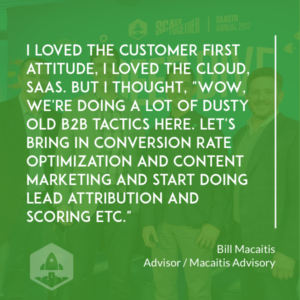
I came in and it was an amazing company. I loved the customer first, I loved the cloud, SaaS. But I was like, “Wow, we’re doing a lot of dusty old B2B tactics here. Let’s bring in conversion rate optimization and content marketing and start doing lead attribution, and scoring, and…”
Matt: So at the time, that wasn’t happening.
Bill: It was just in its infancy. That’s why it was fun for me, and I think part of the reason that Kendall, Marc, and the team had brought me in. I think they wanted to infuse the B2C into the B2B. That’s something I always respected about Marc, was that customer centricity. Enterprise software was crap back then. It still is, in a lot of cases.
Marc was always just inspired by Amazon. Make enterprise software easy to use, and don’t have these massive “It takes one year to train you up.” I thought that we had disrupted so much on the product standpoint, let’s disrupt on the go to market standpoint too, and bring in some of these best practices and leading engines to feed this massive sales engine.
We had to think about how we could scale that and operationalize it and diversify our sources beyond PR, which was amazing in the word of mouth, but we needed to scale and diversify.
Matt: Do you think that B2C mindset was new to the enterprise? Was anyone else doing that or was Salesforce pretty new in doing that?
Kendall: I don’t think anybody was. It was interesting. I was transitioning to run marketing from a guy named Clarence So. Clarence had been interviewing Bill and we were like, “This guy is from the B2C world. He doesn’t know anything about enterprise software, but he knows all these things about getting people to these websites.”
We really tried to find somebody who was completely the opposite, in many ways, of who we were and what our skill sets were. We were very lucky to find him. He saw the potential, which is like, “How can this company be doing so well yet still not be doing a lot of these things digitally at the level that a B2C company would?”
Matt: Just the stuff we take for granted. Now Salesforce is a billion dollars, post IPO company. David, what were the big innovations that happened in the sales organization in order to maintain that growth?
The deals were getting bigger. The sales organization had to change. What were some of the biggest structural, organizational changes that were required to still continue to grow at north of 30 percent at a billion dollars in revenue?
David: A lot of it was harnessing the customer army, getting the stories in place, onboarding really quickly both on the tool, on the messaging, on the product. There was a lot of infrastructure at play. ’07, we had the massive investment, brought Claus Moldt on, and spent 50, 60 million on the data centers. That was a fun year.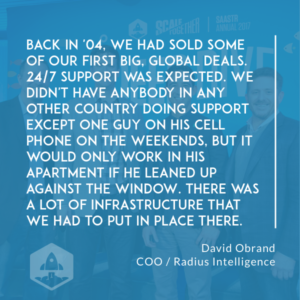
Back in ’04, right when you started, we had sold some of the first big, global deals that we had done. 24/7 support was expected and all that. We didn’t have anybody in any other country doing support. We had one guy basically on his cell phone doing support on the weekends, but his cell phone would only work in his apartment if he leaned up against the window.
These were the real issues. We had to go talk to the CIO of Cisco about why we weren’t answering the calls for like 48 hours, because it was really cold and the guy didn’t want to lean up against his window, so his phone wouldn’t ring.
There was a lot of infrastructure that we had to put in place there. We had to think about follow-the-sun support. Every year, Marc was really methodical about how we would evolve the customer success team. That went from being an account management team in the beginning to being proactive, and I think by ’04 or ’05, starting to get into the sales cycle early on.
We didn’t have this natural drop off between selling the deal and implementing the deal, which was very revolutionary. Figuring out how we would build the AE army, which was in the V2MOM every year for five or six years.
Kendall: It’s probably still on there, I don’t know.
David: Probably.
Kendall: If you’re out there, you can raise your hands if it is.
David: I know Mike Creeden would know. I can see him back there. A lot of it was just infrastructure, and it was also changing the messaging. The messaging had to evolve to CIOs of highly regulated businesses.
Matt: You talked about infrastructure, so that’s making sure the product’s reliable and then that the customers have good support, you’re supporting them after the fact.
I’d like to hear from the rest of the panel. You’re starting to take off big accounts. You’re selling, in many cases, directly to CIOs as opposed to line of businesses. That probably requires bringing in a different set of sales executives and sales managers. What were some of the big changes, as you’re moving from 25, 30k deals to 100, 200, 500k deals and probably still relevant today?
Kendall: It was a huge change in the sales organization. I would say it was kind of fascinating. If you look back at that time, Marc was really focused on two numbers at a company level in terms of hiring. One was the number of developers, and the other was the number of quota carrying salespeople.
We looked at the ratio of people who could write code, and the ratio of people to support them, UX, doc, QE, whatever it might be, and then the number of people who could carry quota, and the number of people who would support them in marketing and SC and BDRs and all these other groups.
He was maniacally focused on building that army, which you’re articulating. It was one of the most important things Salesforce did, was it kept taking those hiring targets, but then Marc was also trying to bring in very different kinds of people.
This is where the company had a lot of experiments, let’s just say, some that worked and some that didn’t work, because we were in unchartered territory.
Matt: What were some of the things that didn’t work?
Kendall: I don’t want to name any names, but there were some people that did not work.
Matt: Say strategies. Not people, but maybe strategies.
Bill: I’ve got a good one.
Kendall: Yeah, go ahead, Bill. Good, save me.
Bill: We hit the ceiling in the growth cycle. We started to get into the enterprise in social. Marc comes out with this positioning of the social enterprise, right?
It was just great because Marc is always five years ahead. He’s pitching the press and the analysts. They love it and they’re eating it up because you can really go into it. That ended up manifesting itself on the home page. It was “Salesforce, a social enterprise.”
At that point, we had put in all of these analytics. We were doing feedback, and people were coming to the home page. We were starting to see drop offs. We asked some people, “What’s going on?” They’re like, “Well, you just sell software for nonprofits. I don’t know what you do. What is this?”
We had to keep iterating off of that, but it was just something where we always had that push and pull of that far reaching vision and just when people came and actually explaining it in words that they understood. That was a fun one.
Kendall: Yeah, that was a fun experiment. The launch of Chatter was a fun experiment, whether it was buying a Super Bowl ad, which was the best B2B Super Bowl ad that year. It was the only B2B Super Bowl ad that year.
Trying to explain something with even the analogy of Facebook at that time, when Facebook was going through its own very difficult time in terms of privacy, and it was under attack in the media, and we were trying to use that metaphor. It was not a good experiment.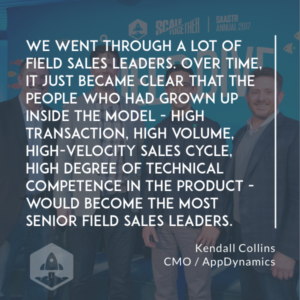
Some of the experiments I was talking about was, I would say, different types of field sales leaders. We went through a lot of field sales leaders. The fascinating thing is that, over time, it just became clear that the people who had grown up inside the model, had grown up in a high transaction, high volume, high velocity sales cycle, high degree of technical competence in the product.
Those people, you think about the Warren Wicks, the Eric Eyken Sluyters, these guys who came out of the corporate business, they became the most senior field sales leaders. We would keep trying to bring in a lot of these field sales leaders from the outside, but they just had never seen a model like this before.
Some of them adapted better than others, but I would say, I don’t know what you felt, but I felt like the homegrown talent and having this very strong pyramid of qualifying reps, outbound BDR reps, inside reps, outside reps…Having this really strong pyramid and career hierarchy is probably one of the most important things Salesforce ever built, because every time you try to bring in different people who are from another planet, they just couldn’t really understand it or adapt to it. A couple did, I don’t know what you think.
David: Yeah. There was that period of time where we started doing really big deals, but to Kendall’s point, we didn’t have a lot of people that had done big deals. We would bring people in from other walks of life, but…
Matt: When you say other walks of life, other…
David: Traditional enterprise software companies. But it was a different unit of measure. We wanted big deals, but we wanted customers to be successful more than we wanted big deals. We wanted both.
A lot of times, you had to break a lot of glass in the traditional enterprise software companies to go get big deals, but once you got the big deals, it was up to the customer to drive their own success. That mindset did not exist in Salesforce. It was always on us to drive the customer’s success.
Up until today, still, you could email Marc at ceo@salesforce.com.
Matt: He will respond?
David: He will. We had times even in ’07, ’08, ’09, where he’d get an email from a five person shop, and he would be just as upset if we failed to deliver success, that he would if it was a 100,000 user deal. That’s a tough mindset for a salesperson coming from a traditional enterprise software company, so there was a lot of tissue rejection.
Kendall: These guys…Well, Slack. I don’t know if they were the first, but they’re definitely one of the most successful to pay people on customers sat, the salespeople. It was huge, but it was a similar mindset, even if we didn’t necessarily have that built in at the time.
We had it built in, in the fact that you couldn’t do add on deals if they weren’t successful with the first five seats. They weren’t going to buy the next 10. They weren’t going to upgrade, so success was baked in from that perspective.
David: You guys extended it even further at Slack, right?
Bill: Yeah.
David: With the credits for usage.
Bill: I was always just inspired by Marc and just his relentless focus on the customer. One of the nice things about when you move on, you’re sometimes coming into these organizations. Like Slack, I was the first go to market employee and Zendesk, first go to market employee. You have an open greenfield, and design it.
I just thought, as we start to build out our own AE teams, and Slack does have salespeople. I know sometimes [inaudible 24:36], but we do. But maybe rethink about, if customer success is our most important thing, why not think about alternative metrics, and maybe we comp them based on the average NPS order score?
We were, I think, one of the first ones, we actually do a post survey after you buy from us. We’ll go to the owner and go, “Hey, was your salesperson, were they responsive? Were they intelligent? Were they knowledgeable? Did they help you out?” because we wanted to combat…
We even tried iterating on pricing. You basically only get charged if you actually use the product, and you would get refunds back. If anyone stopped using Slack in 14 days, you’d get a refund.
I just think it really inspired me, though, by Marc and the roots of customer success and always hearing that. You mentioned V2MOM earlier. I thought that was another great thing we did. It’s Vision, Values, Methods, Obstacles, and…Metrics?
Matt: Measures.
Kendall: I think Metrics.
Matt: Or Measures.
Bill: But the awesome thing about that was it kept everyone on the exact same page, as we went from 100 people to 1,000 to 3,000 to 10,000. Marc wrote at the very top, it was always customer success. Everyone on the entire organization had to fill one out with their priorities. It was amazing for keeping us focused.
Matt: Talk about the importance of Dreamforce, and how that aligned the company and what the product goals were for the year and the messaging. How influential do you think that was in the growth of the company?
David: It was huge. It created a movement. It was the catalyst that drove that user community. The first one we did was at St. Francis.
Kendall: Yeah. I only missed one. I missed the very first one.
David: It was, I think, 50 people in Exec Summit and 700 total, or something like that. We were giving tickets away at the end, just to fill up a ballroom.
The technology was such a break from what everyone had dealt with before. It really did change the division of labor for lines of business to control their own destiny and not be tethered to IT and the slow changes that you saw there with traditional software.
It was really an empowering movement. From the very beginning, Marc brought that compassionate capitalism into it. We were doing philanthropic work from the very first time. It created this connection that people felt to a B2B product, that they didn’t have before.
Matt: Kendall, talk about how it was different from other user conferences that you had seen in the past, and particularly at rallying customers.
Kendall: It’s unusual when you see grown men standing in line to have their picture taken with a mascot at any point.
Matt: Astro’s here, by the way.
Kendall: Oh, awesome. We’ll get a pic with him.
It definitely had that energy, that I think people were really passionate. I haven’t been to that many user conferences where I’ve ever felt that. By just putting the customers and their stories and their content at the heart of it, it made things personal.
That event became as much about the personal connection as the corporate connection and the connection that people had with each other, not just their connection with Salesforce. That was really important.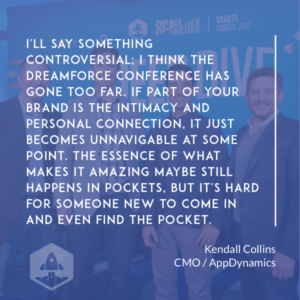
I’ll say something controversial, which is that I think it has gone too far, not just because the traffic, which everyone loves, having the city shut down for a week, and you have to bring in a cruise ship to house people.
But there is an important element of this, which is if part of your brand is the intimacy and the personal connection, and knowing the people that you work with and knowing your peers and your partners and your friends. It just becomes unnavigable at some point.
Personally, I think that has gone off track. It’s just become such a beast, whereas the essence of what makes it amazing maybe still happens in pockets, but it’s hard for someone new to come in and even find the pocket.
Matt: Got it. Bill, in the last few seconds, what did you take from Dreamforce that you’ve taken with you as you’ve gone on to Slack or wherever?
Bill: The development of personality for a B2B brand, that’s something I was inspired by Salesforce, whether it was SaaSy, I believe, back in the day? Little mascot. But just not being afraid to have some personality.
For most B2B organizations before that, the Oracles of the world, they were just completely devoid of any personality. When I went to Zendesk and Slack, that was a big part of it, was the personality. People have an affinity to that brand.
Dreamforce encapsulated that. There was a personality to it. That’s something that definitely helped.
Matt: Great. Thank you all for coming, and thank you for attending.
David: Thank you, guys.
Kendall: Appreciate it.
Bill: Thanks.

